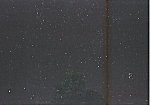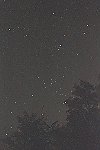 The Big Dipper. The photo was a 10 second exposure with a 55 mm lens at f/2 on Fujichrome
Sensia 100 film. The picture was taken on July 7, 1997, when this constellation was above our
house. A prime focus photo of the double star Mizar (the middle star in the handle) is
available on the
Deep Space page.
The Big Dipper. The photo was a 10 second exposure with a 55 mm lens at f/2 on Fujichrome
Sensia 100 film. The picture was taken on July 7, 1997, when this constellation was above our
house. A prime focus photo of the double star Mizar (the middle star in the handle) is
available on the
Deep Space page.
 The Little Dipper. The photo was a 20 second exposure with a 55 mm lens at f/2.8 on Ektachrome
400 film. One corner star in the bowl was too faint to register in the scanned image, but it
is visible in the original slide. Polaris (the North Star) is at the end of the handle, near
the lower right corner of the picture.
The Little Dipper. The photo was a 20 second exposure with a 55 mm lens at f/2.8 on Ektachrome
400 film. One corner star in the bowl was too faint to register in the scanned image, but it
is visible in the original slide. Polaris (the North Star) is at the end of the handle, near
the lower right corner of the picture.
 This fixed tripod picture of Scorpius was made with a 55 mm lens at f/2 with an exposure
time of 10 seconds on Fujichrome Sensia 100 film. Antares is the bright star just left of
the center of the image. To the eye (and on the original slide), Antares looks very red.
In this computer-processed image, its reddish color is less brilliant.
This fixed tripod picture of Scorpius was made with a 55 mm lens at f/2 with an exposure
time of 10 seconds on Fujichrome Sensia 100 film. Antares is the bright star just left of
the center of the image. To the eye (and on the original slide), Antares looks very red.
In this computer-processed image, its reddish color is less brilliant.
 Sagittarius. The familiar "teapot" shape is easy to see in this picture. The exposure
was 10 seconds on Ektachrome 400 film with a 55 mm lens set at f/2.8. Because the photo
was taken when the constellation was in the southern sky, "trailing" of the stars is
visible on close inspection.
Sagittarius. The familiar "teapot" shape is easy to see in this picture. The exposure
was 10 seconds on Ektachrome 400 film with a 55 mm lens set at f/2.8. Because the photo
was taken when the constellation was in the southern sky, "trailing" of the stars is
visible on close inspection.
 Leo. The exposure was approximately 20 seconds on Fujichrome Sensia 100 film using a 28 mm lens
at f/4. A wide angle lens was used to capture this large group of stars. Regulus (the "heart
of the Lion") is the bright star near the right edge of the picture. It is at the bottom of
the familiar "sickle" shape that forms the front legs and head of the Lion.
Leo. The exposure was approximately 20 seconds on Fujichrome Sensia 100 film using a 28 mm lens
at f/4. A wide angle lens was used to capture this large group of stars. Regulus (the "heart
of the Lion") is the bright star near the right edge of the picture. It is at the bottom of
the familiar "sickle" shape that forms the front legs and head of the Lion.
 Orion with Sirius. This photo of everyone's favorite constellation was made on Fujichrome
Sensia 100 slide film with an exposure of approximately 20 seconds on using a 28 mm wide angle
lens set at f/4 to capture Orion plus Sirius and Aldebaran. In this scanned image, the three
belt stars are easily visible, but the the "sword" stars don't show up. Betelgeuse, whose red
color was lost in the scanning and image processing, is Orion's left shoulder. Rigel is the
bright star at Orions right knee. Sirius, the brightest star visible in the northern
hemisphere, is near the lower left corner of the picture. Aldebaran, the "eye of the bull", is
near the upper right corner.
Orion with Sirius. This photo of everyone's favorite constellation was made on Fujichrome
Sensia 100 slide film with an exposure of approximately 20 seconds on using a 28 mm wide angle
lens set at f/4 to capture Orion plus Sirius and Aldebaran. In this scanned image, the three
belt stars are easily visible, but the the "sword" stars don't show up. Betelgeuse, whose red
color was lost in the scanning and image processing, is Orion's left shoulder. Rigel is the
bright star at Orions right knee. Sirius, the brightest star visible in the northern
hemisphere, is near the lower left corner of the picture. Aldebaran, the "eye of the bull", is
near the upper right corner.
 Cygnus. This was a 10 second exposure on Ektachrome 400 slide film using a 55 mm lens at
f/2.8
Cygnus. This was a 10 second exposure on Ektachrome 400 slide film using a 55 mm lens at
f/2.8
 Hercules. This was a 10 second exposure on Ektachrome 400 slide film with a 55 mm lens at
f/2.8.
Hercules. This was a 10 second exposure on Ektachrome 400 slide film with a 55 mm lens at
f/2.8.
 The "Summer Triangle" isn't really a constellation, but it is a familiar large asterism in
the summer sky. Because of its large size, a 28 mm lens was needed to take in all three
stars. Vega is at the top left of the image, Altair is on the right side, and Deneb is
the brighter of the two stars in the lower left side. The other star that's visible is Sadr,
another star in Cygnus. The exposure was 20 seconds at f/4 on Ektachrome 400 slide film.
The "Summer Triangle" isn't really a constellation, but it is a familiar large asterism in
the summer sky. Because of its large size, a 28 mm lens was needed to take in all three
stars. Vega is at the top left of the image, Altair is on the right side, and Deneb is
the brighter of the two stars in the lower left side. The other star that's visible is Sadr,
another star in Cygnus. The exposure was 20 seconds at f/4 on Ektachrome 400 slide film.
 Photo by Steve Luzader
Photo by Steve Luzader
This photo shows Auriga, marked by the bright star Capella just below the center of the image,
and the bottom part of Perseus, with the star Mirfak at the top center of the picture. An
airplane entered the picture at the left a few seconds before closing the shutter. The
exposure was 20 seconds with a 55 mm lens at f/2 on Fujicolor 200 film.
 Photo by Steve Luzader
Photo by Steve Luzader
This picture shows the top of Auriga at the lower left, the bottom of Perseus starting
with Mirfak at the top left, and the Pleides in the lower right corner. The photo lab cut the
negative because they thought it was blank. The image was reassembled digitally, but a
dark streak was introduced as a result of scanning the cut edges of the film. The exposure
was 20 seconds with a 55 mm lens at f/2 on Fujicolor 200 film.
 Photo by Steve Luzader
Photo by Steve Luzader
Here we see the Pleiades and Taurus climbing from behind a tree in mid-October in our back
yard. Aldebaran is blazing just below the center of the photo, with the "vee" of Taurus
pointing into the tree branches. Aldebaran appears much redder in the photo than it does in
the web image. The exposure was approximately 20 seconds with a 55 mm lens at f/2 on Fujicolor
200 film.